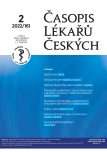Diagnosis of non-alcoholic fatty liver disease and its active screening in risk groups
Authors:
Šimon Dostál; Václav Šmíd
Authors‘ workplace:
4. interní klinika – klinika gastroenterologie a hepatologie 1. LF UK a VFN v Praze
Published in:
Čas. Lék. čes. 2022; 161: 72-76
Category:
Review Article
Overview
Non-alcoholic fatty liver disease (NAFLD) is currently the most common chronic liver disease in developed countries, where it affects up to a quarter of the population. The groups at most risk are diabetics, obese and patients with dyslipidemia, i. e. individuals with advanced metabolic syndrome, in whom the prevalence of NAFLD exceeds 50 %. Some of these patients develop inflammation, so-called steatohepatitis, and subsequent fibroproduction, which in turn can lead to liver cirrhosis with all the complications, especially liver failure, portal hypertension (ascites, esophageal varices) and hepatocellular carcinoma. Therefore recently great emphasis has been placed on actively searching for advanced forms of NAFLD in this population in order to identify and adequately treat these patients in a timely manner. Today, diagnostic methods are widely available and the development of effective therapies for advanced forms of NAFLD is at the forefront of research interest.
Keywords:
elastography – non-alcoholic fatty liver disease – non-alcoholic steatohepatitis – type 2 diabetes mellitus metabolic syndrome
Sources
- Marchesini G, Day Ch, Dufour JF, Canbay A et al. EASL-EASD-EASO Clinical Practice Guidelines for the management of non-alcoholic fatty liver disease. J Hepatol 2016; 64 : 1388–1402.
- Chalasani N, Younossi Z, Lavine JE et al. The diagnosis and management of nonalcoholic fatty liver disease: practice guidance from the American Association for the Study of Liver Diseases. Hepatology 2018; 67 : 328–357.
- Vernon G, Baranova A, Younossi ZM. Systematic review: the epidemiology and natural history of non-alcoholic fatty liver disease and non-alcoholic steatohepatitis in adults. Aliment Pharmacol Ther 2011; 34 : 274–285.
- Pais R, Barritt AS 4th, Calmus Y et al. NAFLD and liver transplantation: Current burden and expected challenges. J Hepatol 2016; 65(6): 1245–1257.
- Poznyak V, Rekve D. Global status report on alcohol and health 2018. WHO, Ženeva, 2018.
- Targher G, Lonardo A, Byrne CD. Nonalcoholic fatty liver disease and chronic vascular complications of diabetes mellitus. Nat Rev Endocrinol 2018; 14(2): 99–114.
- Alberti KG, Eckel RH, Grundy Smet al. Harmonizing the metabolic syndrome: a joint interim statement of the International Diabetes Federation Task Force on Epidemiology and Prevention; National Heart, Lung, and Blood Institute; American Heart Association; World Heart Federation; International Atherosclerosis Society; and International Association for the Study of Obesity. Circulation 2009; 120 : 1640–1645.
- Younossi ZM, Golabi P, de Avila L et al. The global epidemiology of NAFLD and NASH in patients with type 2 diabetes: a systematic review and meta-analysis. J Hepatol 2019; 71 : 793–801.
- Dvorak K, Hainer R, Petrtyl J et al. The prevalence of nonalcoholic liver steatosis in patients with type 2 diabetes mellitus in the Czech Republic. Biomed Pap Med Fac Univ Palacky Olomouc Czech Repub 2015; 159(3): 442–448.
- Monelli F, Venturelli F, Bonilauri L et al. Systematic review of existing guidelines for NAFLD assessment. Hepatoma Res 2021; 7 : 25.
- Brůha R, Dvořák K, Fejfar T et al. Doporučený postup České hepatologické společnosti ČLS JEP pro diagnostiku a léčbu nealkoholové tukové choroby jater (NAFLD). Dostupné na: www.ces-hep.cz/file/602/nafld-dop-postup-chs.pdf
- American Diabetic Association. Comprehensive Medical Evaluation and Assessment of Comorbidities: Standards of Medical Care in Diabetes—2020. Diabetes Care 2020; 43(1): S37–S47.
- Bedogni G, Bellentani S, Miglioli L et al. The Fatty Liver Index: a simple and accurate predictor of hepatic steatosis in the general population. BMC Gastroenterol 2006; 6 : 33.
- Zelber-Sagi S, Webb M, Assy N et al. Comparison of fatty liver index with noninvasive methods for steatosis detection and quantification. World J Gastroenterol 2013; 19(1): 57–64.
- Huang X, Xu M, Chen Y et al. Validation of the fatty liver index for nonalcoholic fatty liver disease in middle-aged and elderly Chinese. Medicine (Baltimore) 2015; 94(40): e1682.
- McPherson S, Stewart SF, Henderson E et al. Simple non-invasive fibrosis scoring systems can reliably exclude advanced fibrosis in patients with non-alcoholic fatty liver disease. Gut 2010 Sep; 59(9): 1265–9.
- Sterling RK, Lissen E, Clumeck N et al. Development of a simple noninvasive index to predict significant fibrosis patients with HIV/HCV co-infection. Hepatology 2006; 43 : 1317–1325.
- Roh YH, Kang BK, Jun DW et al. Role of FIB-4 for reassessment of hepatic fibrosis burden in referral center. Sci Rep 2021; 11: 13616.
- Lichtinghagen R, Pietsch D, Bantel H et al. The Enhanced Liver Fibrosis (ELF) score: normal values, influence factors and proposed cut-off values. J Hepatol 2013; 59(2): 236–242.
- Castera L, Friedrich-Rust M, Loomba R. Noninvasive assessment of liver disease in patients with nonalcoholic fatty liver disease. Gastroenterology. 2019 Apr; 156(5): 1264–1281.
- Vieira Barbosa J, Lai M. Nonalcoholic Fatty liver disease screening in type 2 diabetes mellitus patients in the primary care setting. Hepatol Commun 2021; 5 : 158–167.
Labels
Addictology Allergology and clinical immunology Angiology Audiology Clinical biochemistry Dermatology & STDs Paediatric gastroenterology Paediatric surgery Paediatric cardiology Paediatric neurology Paediatric ENT Paediatric psychiatry Paediatric rheumatology Diabetology Pharmacy Vascular surgery Pain management Dental HygienistArticle was published in
Journal of Czech Physicians

2022 Issue 2
Most read in this issue
